Which Peloton should you buy? We break down the pros and cons of Peloton's full product suite so you know what to expect from each bike and treadmill.
When you buy through our links, we may earn money from our affiliate partners. Learn more.
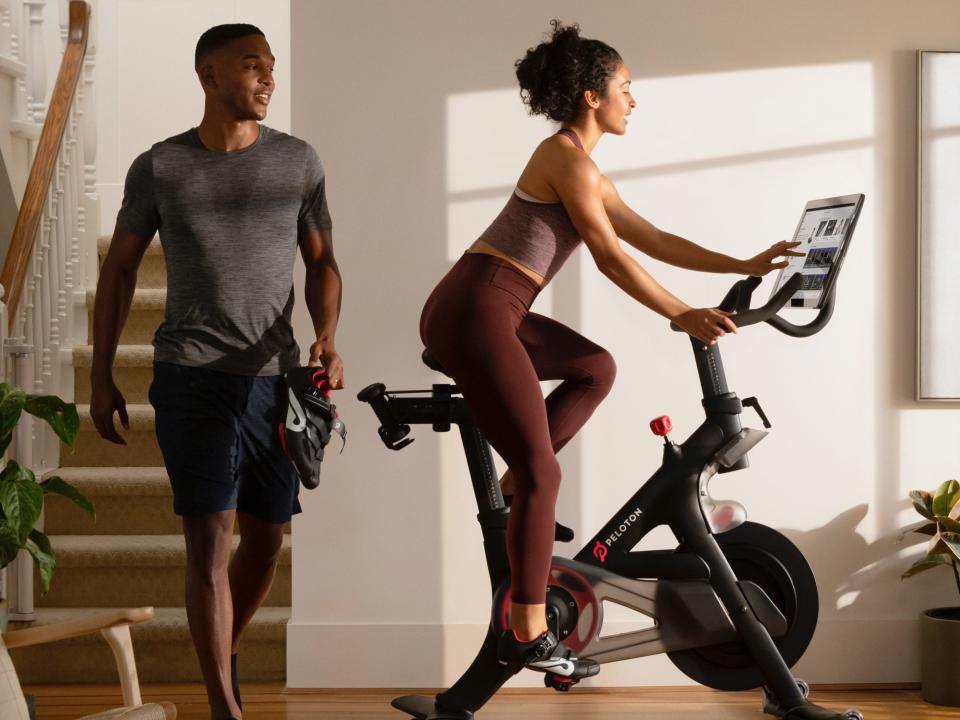
Peloton expanded its lineup of smart workout machines to now include premium options of its popular stationary bike and treadmill.
Called Bike+ and Tread+, the premium machines still offer the same livestreamed and on-demand workouts but feature larger onboard screens and a number of high-end add-ons.
To help pick out which machine is best for you and your fitness lifestyle, we've broken down the pros and cons of both Bike and Tread options, who they're best suited for, and why each is worth the investment.
Sign up for Insider Reviews' weekly newsletter for more buying advice and great deals.
Table of Contents: Masthead Sticky
Editor's note: Peloton issued a recall on October 15 for the clip-in bike pedals on any bike sold between July 2013 and May 2016. The brand says the recall affects roughly 27,000 bikes (and 54,000 pedals). Additional recall information can be found via the Consumer Product Safety Commission.
Few names are as recognizable in the industry of interactive at-home workouts as Peloton. Even when the brand offered a single bike for purchase, it established itself as a fitness phenomenon. With a diverse library of live and on-demand classes and a roster of motivating trainers, it's always been revered as the workout experience.
While that name recognition and popularity persists, Peloton's done well to expand its line of at-home equipment. There's still the tried-and-true Bike, but it also added a premium treadmill called Tread. With a thoughtful design, quality components, and a massive onboard screen that's become synonymous with the Peloton brand, Tread offers those who prefer running the opportunity to join in on the brand's highly sought-after cardio experience.
Peloton expands its lineup
In September of 2020, Peloton announced a substantial expansion to both Bike and Tread and unveiled two new machines that effectively created entry-level versions of its flagships. Specifically, the brand announced a cheaper and slightly smaller treadmill that would take on the standard name of Tread, while also debuting a premium version of the Bike called Bike+.
To round out its lineup, Peloton elevated the existing treadmill to Tread+ while decreasing the price of its iconic Bike to $1,895. With the price drop, Bike became the first machine to sport the Peloton name while also costing less than $2,000.
How to shop Peloton
A wider selection means having to carefully choose which of the four is the best fit for your active lifestyle. And with each machine offering its own set of advantages, there's more to the choice than deciding between buying the budget model or opting for something more premium.
Though sticker price surely has a large impact on your decision-making process, it's crucial to also consider the machine's size, what included features it offers, its versatility, and how valuable it is to your fitness goals. For instance, if it's a smaller machine you need, both the standard Bike and Tread require less of a footprint than their + counterparts. If it's features or versatility you're after, Bike+ and Tread+ are the better choices.
To help make the decision process easier, we've done the legwork to spotlight the pros and cons of each machine below, and also included everything the new machines have that the entry-level models don't.
Here's everything you need to know about Peloton's lineup
Bike
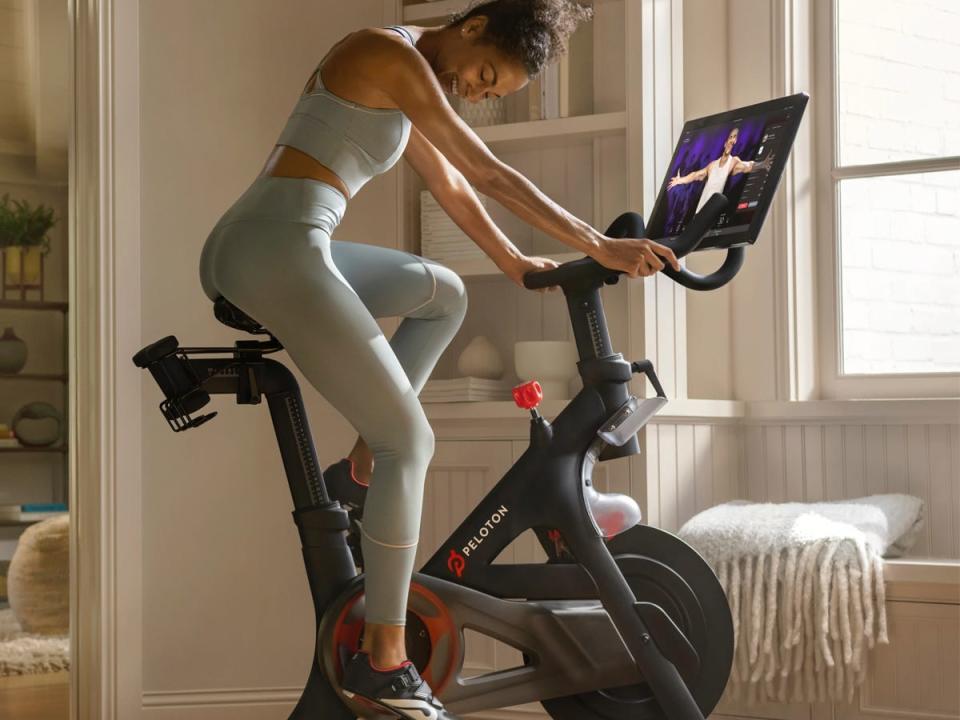
The original Peloton Bike still offers a heart-pumping cycling experience in a premium package that's perfect for spin enthusiasts interested in their first at-home machine.
Who's it for? The standard Bike is best for anyone purchasing their first at-home stationary bike and who doesn't want to spend more than $2,000.
Pros: A high-quality piece of cardio equipment at the cheapest Peloton's ever offered it, membership grants unlimited access to its array of on-demand classes
Cons: Lacks the advanced features afforded the Bike+ such as premium sound or a rotating touchscreen
Peloton's standard Bike measures a reasonable 4 feet by 2 feet making it compact enough to easily fit into a small corner of your home. Its traditional 21.5-inch HD touch screen allows riders to tap into immersive live classes or stream on-demand sweat sessions led by pro trainers that deliver a boutique cycling experience without ever having to step inside an actual studio.
Peloton's basic model starts at $1,895, plus another $39 per month for the Peloton Membership (as is the case for every Peloton machine), which is compulsory with your purchase for the first year. Even after the price drop, it's certainly not a cheap investment but if you're someone who loves cycling and would use it multiple times a week (as you would a gym membership), it's worth the expense.
Bike+
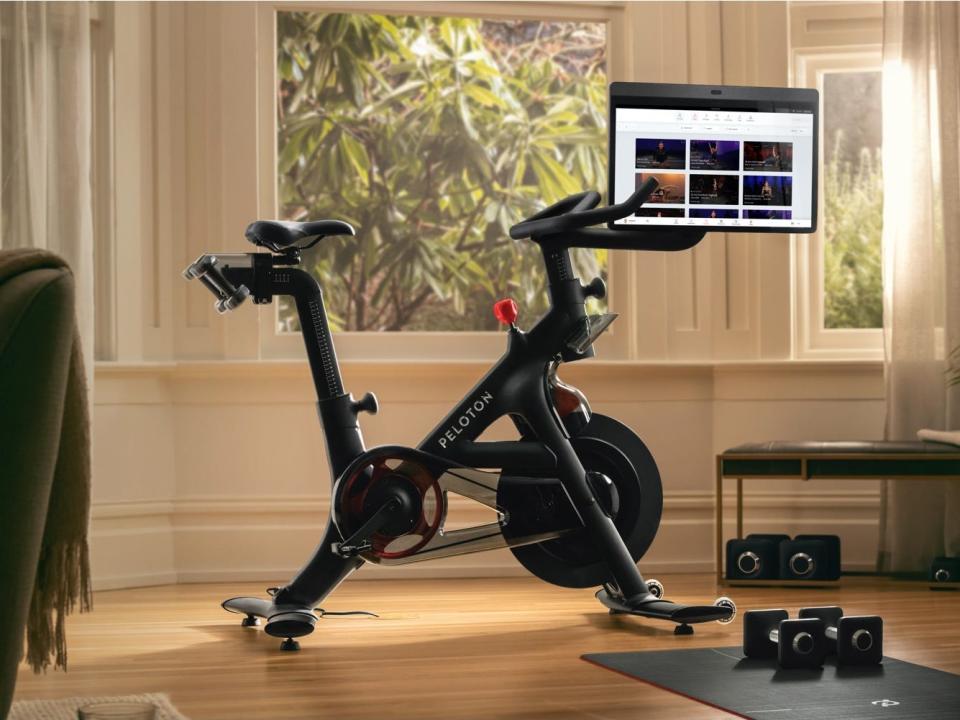
Peloton's new high-end flagship introduces a larger, rotating touchscreen, Apple GymKit integration, and automatic resistance control.
Who's it for? Though it's the most expensive bike Peloton's offered, Bike+ is a highly premium product that's intended for the serious at-home cyclist that won't bat an eye at spending just shy of $2,500 on fitness equipment.
Pros: High-quality cardio equipment, bigger rotating screen caters to your workout, better sound system, great for tracking your fitness progress and goals
Cons: Expensive
The Bike+ is the 2.0 version of Peloton's original stationary bike, designed to its users' desired specifications based on feedback from loyal riders. So, not only is the touchscreen bigger at 23.8 inches but it also now rotates 180 degrees for easy viewing when classes take you off the bike. Though the footprint for Bike+ is similar to the standard model, it is six inches taller and the rotating screen requires a little more leeway for use.
Another advanced feature of Peloton's Bike+ is its high-quality sound system. Instead of relying on just a pair of rear-facing speakers, this model has a four-speaker sound system (two front-facing and two rear-facing), meaning your instructor's voice and/or playlist comes through louder and clearer than ever. In other words, you'll never miss a beat.
Peloton's Bike+ also offers riders the opportunity to track their progress in a more advanced way by integrating with Apple Gymkit and syncing all workouts on the bike to that app. An Auto-Follow digital resistance system has also been added which automatically scales resistance based on Target Metrics and instructor guidance, allowing for more focus on the actual ride as opposed to continuously tinkering with the resistance dial.
The basic Bike+ package costs $2,495 and requires the $39 per month Peloton Membership. Other packages include Bike+ Essentials for $2,695 which comes with a pair of bike shoes, a set of weights, and a reversible mat; Bike+ Works for $2,795 which comes with everything offered in the Essentials package, as well as a bike mat and set of resistance bands; and Bike+ Family for $2,945 which comes with everything in the Works package, as well as an extra pair of shoes, a set of yoga blocks, two water bottles, and yoga straps.
Tread

At just $2,495, Peloton's standard tread is nearly half the price of the high-end Tread+ yet still features a built-in 23.8-inch touchscreen display, incline compatibility, and 59 inches of running space.
Who's it for? The Tread is perfect for anyone with a small workout space who still wants to include a cardio machine in their home gym. With a price of just $2,495, it's inexpensive as far as quality treadmills go, and is nearly half the price of the more high-end Tread+ ($4,295).
Pros: The brand's smallest product, it fits in tight spaces and apartments, adjustable touchscreen
Cons: Still expensive as far as workout equipment goes, the feeling of running on an open treadmill might not be everyone's preference
The Peloton Tread is Peloton's newest addition to the treadmill market and though it won't be available for purchase until March 30, Peloton does have an email list open for people to be notified as soon as it goes on sale.
The Tread is essentially a smaller, more affordable version of the brand's first treadmill. With dimensions of 68 inches long by 33 inches wide and 62 inches tall, it's the perfect addition for smaller home gyms in apartments, spare rooms, or small garages. But just because it's more compact doesn't mean the brand skimped on features.
The Tread's touchscreen is 23.8 inches and tilts up and down up to 50 degrees, allowing it to be adjusted based on the kind of workout being streamed. It also comes with integrated speakers and a knob that controls both its speed and incline.
Unlike traditional belt treadmills, the Tread has no front shroud, so it feels like you're sprinting on a natural road rather than an engineered machine. Though this may take some getting used to, the learning curve isn't entirely steep (nor is it much different from the Peloton's first Tread, now called Tread+).
Tread+
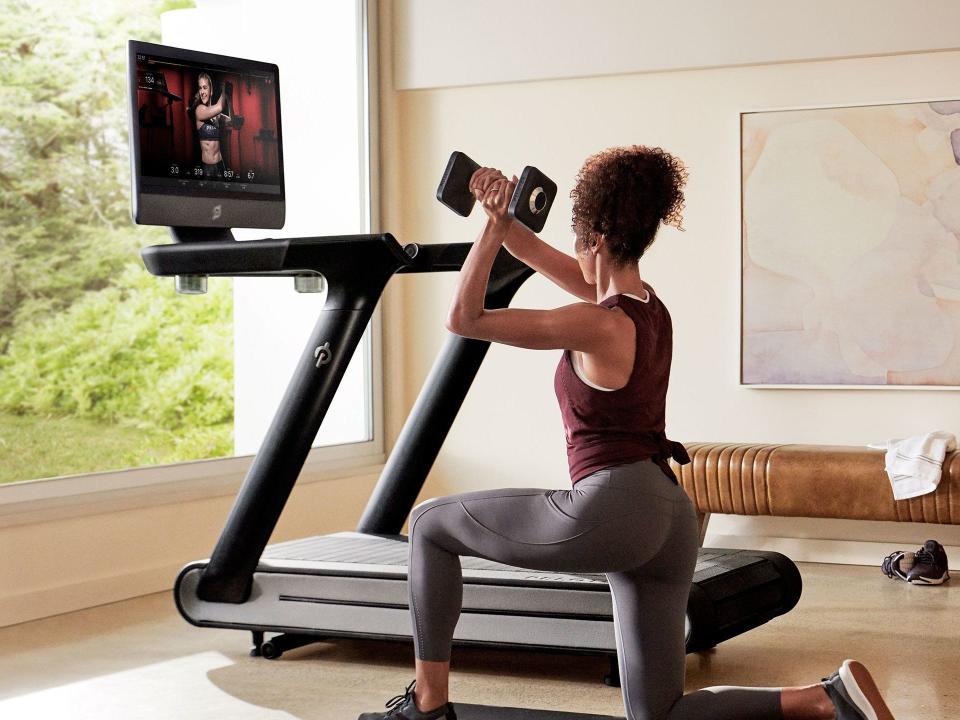
The original Peloton treadmill got a title change and still offers an array of premium features like a 32-inch touchscreen, a shock-absorbing slat belt, a whopping 67 inches of running space, and an impressive built-in soundbar.
Who's it for? Tread+ is for the dedicated runner who intends to use the machine almost every day and who has the space (and money) for a premium treadmill.
Pros: Features a shock-absorbing belt that's comfortable and supportive, has easily accessible knobs that adjust the speed and incline, large touchscreen, powerful sound system, connects to Bluetooth
Cons: Very expensive, big, takes up a lot of room
Peloton might be best known for its stationary bike, but the fitness brand's treadmill is also beloved. For those who aren't yet familiar, the Peloton Tread+ offers an elevated cardio experience for anyone who prefers running or walking to cycling. It was also designed to provide users the option to train the full-body, so you can hop on for some cardio then jump off to join other types of classes, like core strengthening, yoga, or Bootcamp.
Like traditional treadmills, the Tread+ is a large and heavy piece of equipment. This won't be folded up to slide into a closet or shuffling between rooms — and that's fine, too. It's intended to be the centerpiece of a home gym, so long as that home gym has enough space to satisfy the Tread+'s footprint.
This model also differs from its Tread counterpart in that it features a shock-absorbing belt made of 59 individual slats. This unique belt ensures your feet are supported and comfortable throughout the workouts and while it may not seem like much, it makes a world of difference and was something we instantly noticed (and appreciated) during our own tests.
Other features include a 32-inch touchscreen display, a 20-watt built-in soundbar that also offers Bluetooth connectivity (so you can play your own music), and easy-to-use knobs that control both the incline and speed of the treadmill.
A product of this quality also comes with a premium price tag and the Tread+ carries a price tag of $4,295. Like the other machines, this doesn't include the $39 per month subscription to the classes, though considering how much this all-in-one system offers, you'll likely never have to set foot in a gym again (unless, of course, you want to).
Is the monthly membership worth it?
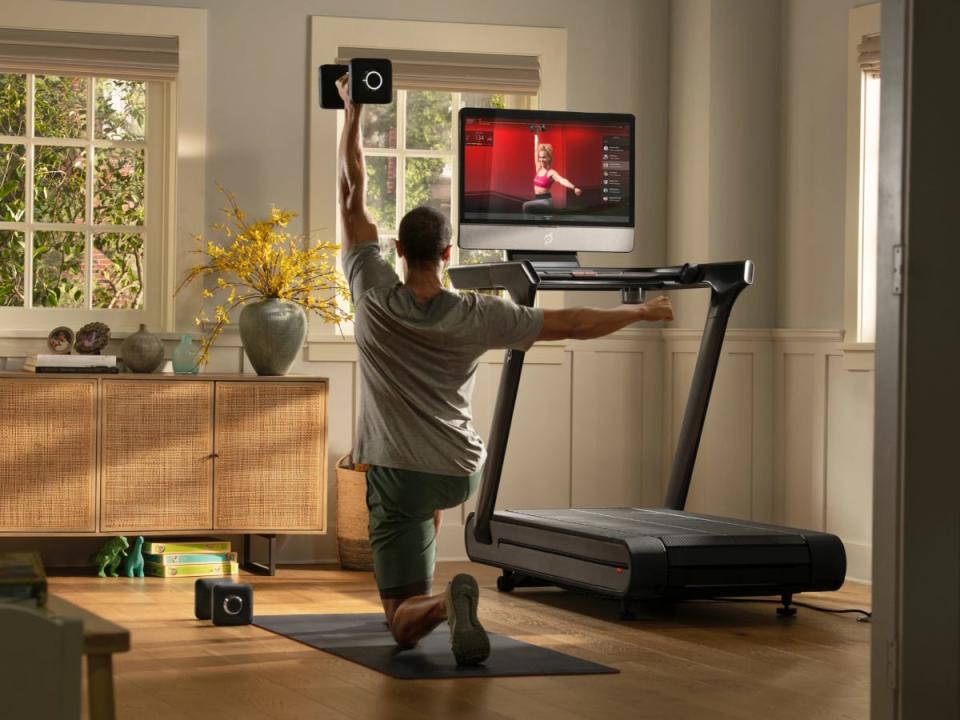
Think of the $39 membership as an all-access pass to a top tier gym or boutique studio. It's costly on top of what you're already paying for the equipment, but well worth the price of admission for its expansive offering of classes that aren't just focused on stationary bike or treadmill sessions.
Peloton divides its classes into 10 different fitness categories all accessible via the Peloton Digital Membership. Off the Bike or Tread, members can access Strength classes that use equipment like free weights or a mat to work different areas of the body. Meditation exercises are also offered and can be supplemented pre- or post-workout to motivate you or calm your body. There are also meditative sessions that help promote better sleep.
Each class type offers a wide selection of live classes each day, as well as access to the library of pre-recorded sessions that can be streamed on-demand. Maybe there's a particular yoga session you enjoyed that you want to repeat, or a specific Bootcamp class you want to get better at. You have access to these, and thousands more, at any time.
If it's the Bike or Tread you plan on using most, the array of classes offered for either machine is extensive. Bike classes range from 20 to 60 minutes and can either be speed-focused sessions, music-specific routines, or more intense cardio workout like its Climb or HIIT Rides.
The brand also rolled out a series of new Bike Bootcamp courses which are described as a full-body workout "integrating strength training with Peloton's well-known cardio programming to take your training to the next level." Our advice? Prepare to sweat.
As for Peloton Tread+ and Tread users, the brand's running workouts are unmatched. Sessions last anywhere from 10 to 60 minutes and range from music-heavy, themed runs, such as the EDM Fun Run, to length-specific classes, such as its Endurance Run. Walking workouts span 20 to 45-minutes long, and include walk/run routines, power walking, and some incline-heavy hike-like classes.
Read the original article on Insider

